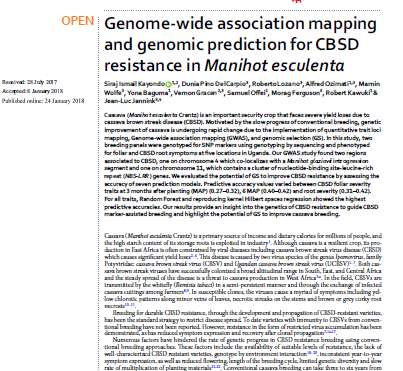Cassava (Manihot esculenta Crantz) is an important security crop that faces severe yield losses due to cassava brown streak disease (CBSD). Motivated by the slow progress of conventional breeding, genetic improvement of cassava is undergoing rapid change due to the implementation of quantitative trait loci mapping, Genome-wide association mapping (GWAS), and genomic selection (GS). In this study, two breeding panels were genotyped for SNP markers using genotyping by sequencing and phenotyped for foliar and CBSD root symptoms at five locations in Uganda. Our GWAS study found two regions associated to CBSD, one on chromosome 4 which co-localises with a Manihot glaziovii introgression segment and one on chromosome 11, which contains a cluster of nucleotide-binding site-leucine-rich repeat (NBS-LRR) genes. We evaluated the potential of GS to improve CBSD resistance by assessing the accuracy of seven prediction models. Predictive accuracy values varied between CBSD foliar severity traits at 3 months after planting (MAP) (0.27–0.32), 6 MAP (0.40–0.42) and root severity (0.31–0.42).
For all traits, Random Forest and reproducing kernel Hilbert spaces regression showed the highest predictive accuracies. Our results provide an insight into the genetics of CBSD resistance to guide CBSD marker-assisted breeding and highlight the potential of GS to improve cassava breeding.
Region: Uganda
Date published:
2018
Published by:
Scientific Reports
Type of resource:
Journal article
Resource topic:
Cassava
Project/Programme: Not specific
Pest/Disease: Cassava brown streak virus
Pages:
11
File type:
External link (1,921 KB)




